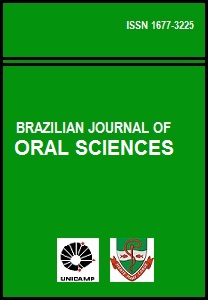Abstract
Aim: To evaluate the influence of the viscosity and curing mode on the bond strength of two resin cements to dentin. Methods: Eight experimental groups were formed (n = 7) according to the dual-cure resin cements (Nexus 2 - Kerr Corp. and Variolink II - Ivoclar Vivadent), curing modes (dual-cure or self-cure) and viscosities (low and high). Resin cements were applied to pre-cured composite resin discs (2 mm thick, Sinfony -3M ESPE), which were fixed to bonded dentin surfaces. The restored teeth were either light-activated (XL3000 - 3M ESPE) or allowed to self curing only. After 24 h, the teeth were both mesiodistally and buccolingually sectioned to obtain bonded beam specimens (0.8 mm2 cross-sectional area). Each specimen was tested in microtensile strength at a crosshead speed of 0.5 mm/min until failure. Results: Data (in MPa) were analyzed statistically by three-way ANOVA and Tukey’s post-hoc test (pre-set á = 0.05). No significant difference was observed between resin cements (p=0.26) and viscosities (p=0.13), however, the curing mode affected the BS within the viscosities (p=0.01). Statistically significant difference was observed for low viscosity: Nexus 2: 23.8(10.6) (dual-cure) and 16.0(5.1) (self-cure); Variolink II: 28.7(8.7) (dual-cure) and 11.9(3.0) (self-cure). Conclusions: Light activation yielded higher bond strength for the low-viscosity versions of the resin cements.The Brazilian Journal of Oral Sciences uses the Creative Commons license (CC), thus preserving the integrity of the articles in an open access environment.
Downloads
Download data is not yet available.

